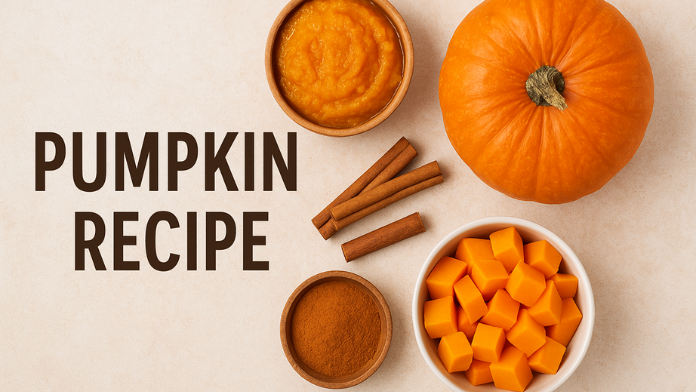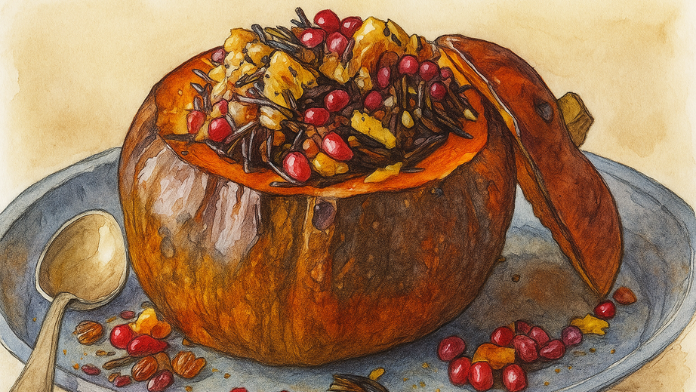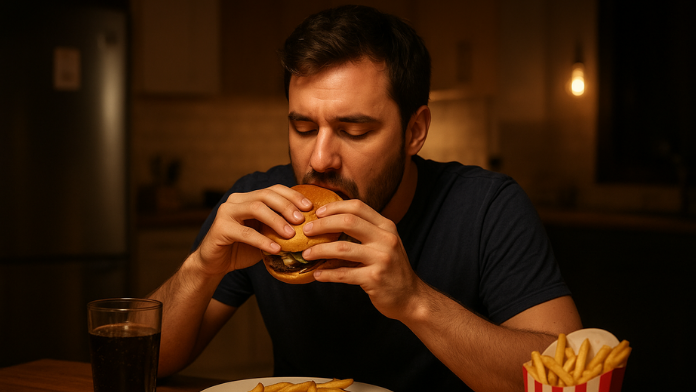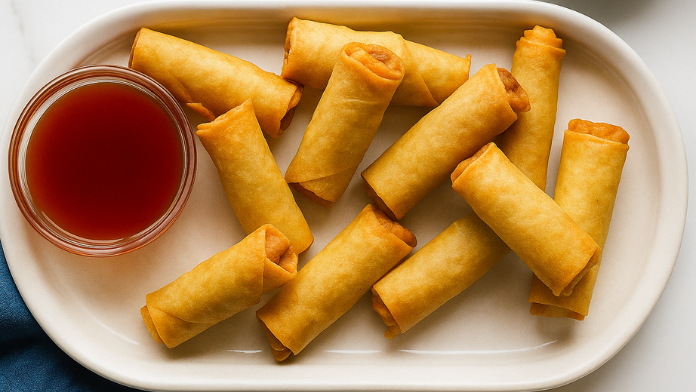
If you’re looking for richer flavour without the guilt, you’ve come to the right place. In this article you’ll discover how to turn the humble pumpkin into indulgent-tasting dessert-style treats, with smart ways to lighten up classic favourites. With pumpkin recipes that taste like dessert, you’ll satisfy your sweet-tooth while staying focused on health and nutrition. We’ll cover: what makes pumpkin a powerhouse ingredient; how to pick and prepare pumpkin (fresh vs canned); five standout healthy dessert-style pumpkin recipes; two savoury-sweet bonus ideas; common pitfalls to avoid; and a practical summary to keep things simple. Let’s dive in.
Why Pumpkin Belongs In Dessert-Style Cooking
Health credentials of pumpkin
Pumpkin is more than just a seasonal flavour. Nutrition-wise, it offers fibre, vitamins and minerals that support health. For instance, canned pumpkin can be used to reduce fat and sugar in baked goods while retaining moisture and sweetness. It’s also naturally low in calories: one cup of cooked pumpkin has about 50 calories and roughly 3 g fibre.
What “dessert-style” means without going overboard
When I say “tastes like dessert”, I don’t mean full sugar, full cream indulgence. I mean rich flavour, satisfying texture, and a sense of treat-time — but done with better ingredients, less refined sugar, more whole grains (or none), and smart swaps. Many recipe collections label “healthy pumpkin recipes” that include muffins, bars, cookies, smoothies and more.
Why pumpkin works as a dessert base
- Its natural flavour is mildly sweet and pairs beautifully with spices like cinnamon, nutmeg and ginger.
- Its moisture content helps baked goods stay tender (so you can use less fat).
- It’s versatile: you can use canned pumpkin (which is consistent and convenient) or fresh roasted pumpkin if you prefer.
- The familiar flavour cue of “pumpkin spice” means you can create dessert-style treats that feel indulgent without full sugar loads.
Smart Preparation: Choosing & Preparing Pumpkin Recipes

Fresh vs canned pumpkin
- Canned pumpkin puree: Ultra convenient. Make sure you buy 100% pumpkin (not “pumpkin pie filling” which often includes added sugar/spices). Many recipe authors recommend it for texture and flavour consistency.
- Fresh pumpkin: Offers more control (you choose variety, roast it, maybe leave some texture). But takes extra prep (peeling, removing seeds, roasting, puréeing). Unless you already love cooking from scratch, canned is fine for many dessert-style uses.
Key prep tips
- When baking, watch the moisture: pumpkin purée adds a lot of wetness, so if your batter is too loose, consider reducing other liquids or adding a little extra flour/whole grain.
- Choose the right variety if you use fresh: sugar pumpkins or smaller pie-type pumpkins tend to yield better flavour than giant carving pumpkins.
- If using canned, check the label: 100% pumpkin (no added sweeteners or spices).
- Store leftovers: cooled purée can be portioned, sealed and frozen for later use (especially handy for desserts or breakfast recipes).
- Spicing matters: classic dessert spices (cinnamon, nutmeg, cloves) or pumpkin-pie spice blends elevate the taste.
Health-savvy swaps
- Use whole-grain flour (whole wheat, oat flour) or partly replace flour with oats to increase fibre.
- Swap refined sugar for maple syrup, honey or a moderate amount of natural sweetener. Many healthy pumpkin desserts use these alternatives.
- Add protein or fibre: e.g., Greek yoghurt, beans (in blondies), oats, seeds to boost satiety.
- Portion control is still important: even a healthier dessert contains calories.
Five Healthy Pumpkin Recipes That Feel Like Dessert
Below are five recipe-ideas (not full step-by-step instructions) explained in a practical, actionable way so you can choose what fits you, adapt for ingredients you have, and get the treat-feeling with fewer compromises.
1. Pumpkin Oat Bars (Whole-grain & satisfying)
A great choice if you want something you can slice into snack-sized pieces, serve as dessert, breakfast or mid-afternoon treat. Inspired by “Healthy Pumpkin Bars” using more oats than flour.
Why it works:
- Oats bring complex carbs + fibre which slow digestion and help you feel full.
- Pumpkin brings moisture, flavour and colour with vitamins and fibre.
- When you reduce sugar and use whole grain flour (or oats only) you get a treat with substance.
How to make it your own:
- Use 1 cup pumpkin purée + 1–1¼ cup rolled oats (ground slightly or mix with whole) + ½ cup whole wheat or oat flour.
- Spices: 1 tsp cinnamon + ¼ tsp nutmeg + pinch cloves.
- Sweetener: ¼–⅓ cup maple syrup or honey (adjust to desired sweetness).
- Optional: ¼ cup chopped nuts or pumpkin seeds for texture.
- Bake at around 175 °C for ~20–25 minutes until set but still moist. Cool before slicing.
- Store in fridge for up to 4–5 days, or freeze slices.
Flavor tip: Serve with a dollop of Greek yoghurt + a drizzle of honey for extra “dessert” feel.
2. One-Bowl Healthy Pumpkin Muffins
When you crave something warm, comforting and cupcake-like but want better ingredients. Many healthy recipe versions exist.
Why it works:
- Muffins are evocative of desserts, but you can lighten them by using whole red-grain flour, less sugar, added pumpkin purée and spices.
- Portion size built in (one muffin) helps control.
How to build it:
- Base: 1¼ cup whole wheat pastry flour (or combination of whole wheat + oat flour) + ½ cup baking-blend rolled oats.
- Wet: 1 cup pumpkin purée + ½ cup low-fat milk or plant-based milk + ½ cup maple syrup or honey + 2 eggs (or flax eggs).
- Spices: 1 tsp pumpkin pie spice (or cinnamon + nutmeg + ginger) + ½ tsp baking powder + ¼ tsp salt.
- Optional: ¼ cup chopped dark chocolate or cacao nibs for “dessert-style” feel.
- Bake at 180 °C for ~20 minutes until a toothpick comes out clean.
Pro tip: Mix in ¼ cup Greek yoghurt to boost protein and keep muffins moist for longer.
3. Pumpkin Chocolate Chip Cookies (Better-for-you treat)
Who doesn’t love cookies? Turn them into pumpkin-infused, gourmet-tasting treats with smart swaps. Recipe frameworks show you can use minimal refined sugar and flour.
Why it works:
- Cookies feel indulgent, but when you build them around pumpkin purée + oats or almond flour, you cut down the empty calories.
- Use dark chocolate chips for a richer taste, less sugar.
How to do it:
- Mix: 2 cups rolled oats (or 1 cup oats + 1 cup almond flour) + 1 cup pumpkin purée + ¼ cup maple syrup + 1 tsp vanilla extract + 1 tsp pumpkin pie spice.
- Fold in: ¼–⅓ cup dark chocolate chips (70% cocoa or higher).
- Chill dough for ~30 minutes so the texture holds.
- Bake at 175 °C for ~12–14 minutes until edges are lightly golden. Let cool on tray (they’ll firm up).
Tip: Add 2 Tbsp ground flax + ½ cup chopped walnuts for added fibre and healthy fats.
4. No-Bake Pumpkin Bars / Energy Bites
Ideal when you don’t want to turn on the oven. These are great for snack-dessert hybrid – something you can grab, feel indulgent, yet built clean. Example: flourless healthy pumpkin bars with almond butter and purée.
Why it works:
- No baking means less hassle, quicker prep.
- You can use base ingredients like dates, oats, pumpkin purée, nut/seed butter and keep sugar minimal.
- They behave like dessert bars, but you control the ingredients fully.
How to make it:
- Base layer: 1 cup dates (pitted) + 1 cup rolled oats + ¼ cup almond (or peanut/pumpkin-seed) butter + ½ tsp vanilla. Process until crumbly/pressable. Press into lined pan.
- Top layer: 1 cup pumpkin purée + 2–3 Tbsp maple syrup + 1 tsp pumpkin pie spice + optional ¼ cup chopped dark chocolate. Spread on base layer.
- Chill in fridge ~2 hours until firm. Slice into bars.
- Store covered in fridge up to 5-6 days.
Note: Because they are rich, slices can be smaller than you’d expect (e.g., 16 bars instead of 12) to keep portion moderate.
5. Pumpkin Parfait or Mousse Style Treat
If you prefer something spoon-able, creamy and layered rather than baked, this is for you. You get the dessert texture (think mousse, parfait) but built around pumpkin base + Greek yoghurt or plant-based yoghurt. Many healthy pumpkin dessert collections list “pumpkin mousse” or “pumpkin pie-in-a-cup”.
Why it works:
- Combines texture contrast: smooth pumpkin layer + crunchy granola or nut topping → makes it feel like a dessert.
- You can control sweetness, use yoghurt for protein, spice for flavour.
- Ideal for a make-ahead treat: portion into jars.
How to build it:
- Pumpkin layer: 1 cup pumpkin purée + ½ cup Greek yoghurt + 2 Tbsp maple syrup or honey + 1 tsp vanilla extract + 1 tsp pumpkin pie spice. Blend until smooth.
- Layer: In jars, add ½ cup granola or crushed whole-grain biscuits at bottom, then pumpkin-yoghurt layer, then top with chopped pecans/pumpkin seeds + fresh fruit (berries work well).
- Chill 1 hour before serving.
Pro tip: For a vegan version swap yoghurt for coconut-based or plant-based yoghurt and use maple syrup.
Bonus: Two Savoury-Sweet Ideas for the Pumpkin Recipes
Even though our focus is desserts, pumpkin shines when you blur the line between savoury and sweet. Here are two ideas to keep in mind.
1. Pumpkin Seed Crunch Topping
Don’t toss those pumpkin seeds! Roast them with warm dessert-style spices (cinnamon, ginger) and sprinkle over yoghurt or baked goods. This adds texture and a flavour echo of dessert.
2. Pumpkin Spiced Latte / Smoothie
When the craving is a creamy drink-dessert, use pumpkin purée in a latte or smoothie with warming spices, milk (or plant milk), and minimal sweetener. Example: a vegan pumpkin spice smoothie made with real pumpkin purée and plant milk.
Watch Out: Common Pitfalls & How to Avoid Them
- Pitfall: Using “pumpkin pie filling” instead of pure pumpkin purée. Many recipes caution: ensure you use pure pumpkin, because the “pie filling” version includes sugar and spices, which adds hidden calories.
- Pitfall: Over-sugaring believing it’s still “healthy”. A recipe built around pumpkin still needs attention to how much added sweetener goes in. If you add heavy sugar and butter, you’ve essentially made a regular dessert.
- Pitfall: Ignoring portion size. Even healthier dessert-style pumpkin treats have calories. If you slice bars too large, the benefit is reduced.
- Pitfall: Texture off because of extra moisture from pumpkin. Pumpkin purée adds moisture; if you don’t adjust flour or oats accordingly, the result can be soggy or collapse. Use tips from recipe authors: reduce liquid, add some extra dry ingredient.
- Pitfall: Thinking “healthy” means no indulgence. You still want to get a treat-feeling: flavour, texture, presentation count. So don’t under-season, don’t skip the crunch or cream layer if that’s what makes it feel decadent.
How to Build Your Own Healthy Dessert-Style Pumpkin Recipes
If you want to experiment beyond the five examples, here’s a simple framework to follow this week:
- Pick your “treat format” – e.g., bar, muffin/cake, cookie, parfait/mousse, smoothie.
- Base ingredient: pumpkin purée – aim for ½–1 cup depending on size.
- Dry components: choose one primary (whole wheat flour, oat flour, almond flour, rolled oats) and maybe a secondary (nuts/seeds) for texture.
- Liquid/sweet components: Keep sweetener moderate (maple syrup, honey, stevia, etc.), account for pumpkin’s moisture.
- Spices & flavour: Use dessert-style spices: at least cinnamon + nutmeg or a pumpkin pie spice blend. Consider vanilla extract or even a little citrus zest.
- Add contrast/texture: e.g., chopped dark chocolate, pumpkin seeds, nuts, granola layer, yoghurt topping.
- Portion size and good packaging/storage: Bake or assemble in appropriate size. For bars/cookies, refrigerate if needed; for parfaits, use jars.
- Test & adjust: If batter too wet, add some extra oats or flour; if too dry, add a splash more milk or purée.
- Label & serve with pride: Present it as dessert (not “diet food”). If it tastes good, you’ll keep making it.
Mini-Summary: Why These Pumpkin Recipes Work
- Pumpkin purée offers moisture, flavour and nutrients — a strong base for dessert-style treats.
- By smartly choosing flours, sweeteners and mix-ins, you get something that feels indulgent yet is better for you.
- Portion, texture and flavour matter just as much as ingredient quality.
- You don’t sacrifice taste; you just tweak the approach so that the sweet treat aligns more with health goals.
- Versatility: bars, muffins, cookies, parfaits, smoothies — there’s a format for every craving and lifestyle.
Conclusion
Dessert-style treats and health-conscious cooking are often presented as opposites, but with the right ingredient choices and mindset you can bridge that gap. The humble pumpkin becomes your ally: it gives you flavour, texture and nutrients all in one. With the pumpkin recipes we’ve covered — from oat-rich bars, one-bowl muffins, cookies, no-bake bars to parfaits — you can enjoy something that tastes like dessert and aligns with better-for-you standards.
Remember: you don’t have to wait for fall to treat yourself — pumpkin works year-round. Stock up on pure pumpkin purée (or roast fresh when it’s in season), experiment with the frameworks above, and keep your treat game both satisfying and smart. Dessert doesn’t have to be off-limits — it just needs a better foundation. Go ahead and make that next slice of pumpkin-infused joy.
FAQs
- Can I use the primary keyword “pumpkin recipes” in one of the FAQ questions?
Yes, you’ll see that below. - Are these pumpkin recipes only for fall?
Not at all — while pumpkin is seasonal in many places, canned purée is widely available year-round, and you can adapt the flavour profiles to any season or mood (e.g., lighter spices in spring/summer). - Can I substitute sugar-free sweeteners in healthy pumpkin desserts?
Yes — you can use monk fruit, stevia or other zero-calorie sweeteners, especially if you’re aiming for very low sugar. However, taste and texture may differ slightly. A moderate amount of natural sweetener (maple syrup or honey) often gives better flavour and satisfaction. - How do I store baked pumpkin treats?
Once baked, let them cool fully. Store in an airtight container in the fridge if they contain yoghurt, nut butter, or high moisture (e.g., bars, parfaits). For cookies or muffins, you can store at room temperature for 1-2 days and then move to fridge. Many bars also freeze well (wrap individually and freeze, defrost before serving). - What if I only have fresh pumpkin, not canned purée?
That’s fine — just roast (or steam) the pumpkin, remove seeds/skin, mash and purée until smooth. Weigh the equivalent (e.g., 1 cup purée ~ 240 ml) and proceed. Check moisture levels though: fresh purée may sometimes be a little wetter or drier than canned, so adjust dry ingredients accordingly. - Can I use these pumpkin recipes if I’m following gluten-free or vegan diets?
Absolutely — many recipe frameworks are easily adaptable. Swap wheat flour for oat flour or almond flour, use flax/chia eggs or egg substitute, and choose plant-based milk/yogurt. Many healthy pumpkin dessert recipe collections highlight gluten-free and vegan options. - Is pumpkin itself high in sugar?
No — pumpkin purée is naturally low in calories and sugar and contains fibre. The sugar content primarily comes from added sweeteners or fillings in recipes, so the key is controlling those additions.










